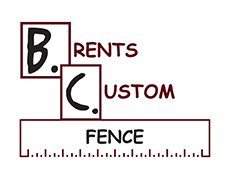Why Composite Privacy Fence Cost Matters for Your Home Investment
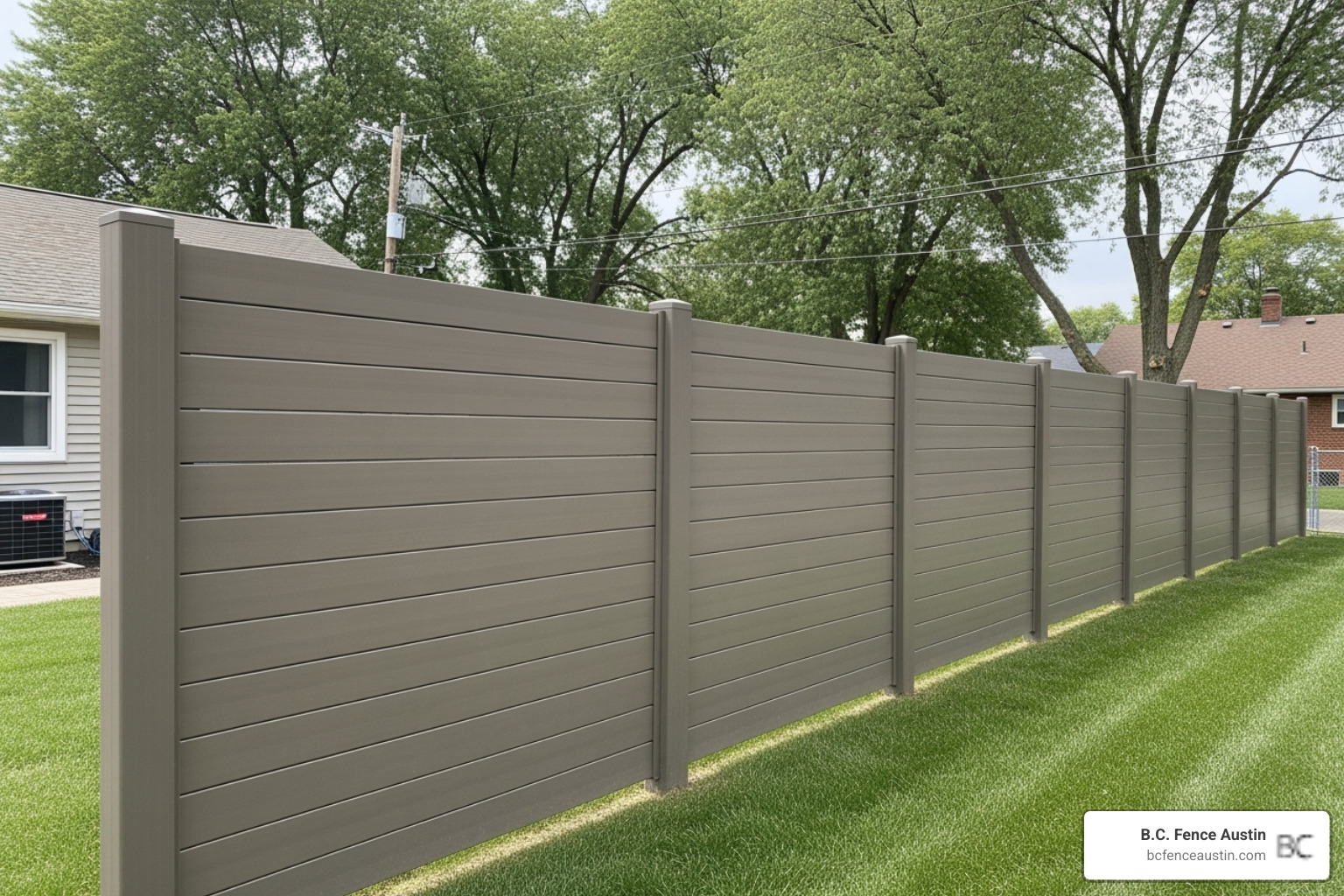
Composite privacy fence cost is a key consideration for homeowners balancing upfront investment with long-term value. If you’re exploring fencing options, here’s what you need to know:
Quick Answer:
- Materials typically range from budget-friendly to premium options depending on quality and brand
- Installation includes labor, post-setting, and site preparation
- Total project expenses depend on fence length, height, and terrain complexity
- Long-term value comes from minimal maintenance and 20-30+ year lifespan
- Composite offers better durability than wood with less upkeep than vinyl
Whether your old fence is looking tired or you’re ready to add privacy and security to your backyard, the question is whether the investment makes sense. Composite fencing, a blend of recycled wood fibers and plastic, offers the look of wood without the constant maintenance. No more staining, and no worries about rot or termites.
For busy homeowners, composite fencing is a solution that stays beautiful. It resists warping in Austin’s intense summer heat, won’t splinter, and never needs repainting. But is it worth the cost?
The answer depends on your property’s needs, how long you plan to stay in your home, and whether you prioritize low upfront cost or low long-term hassle. This guide breaks down the factors influencing your total investment so you can make the smartest choice for your property.
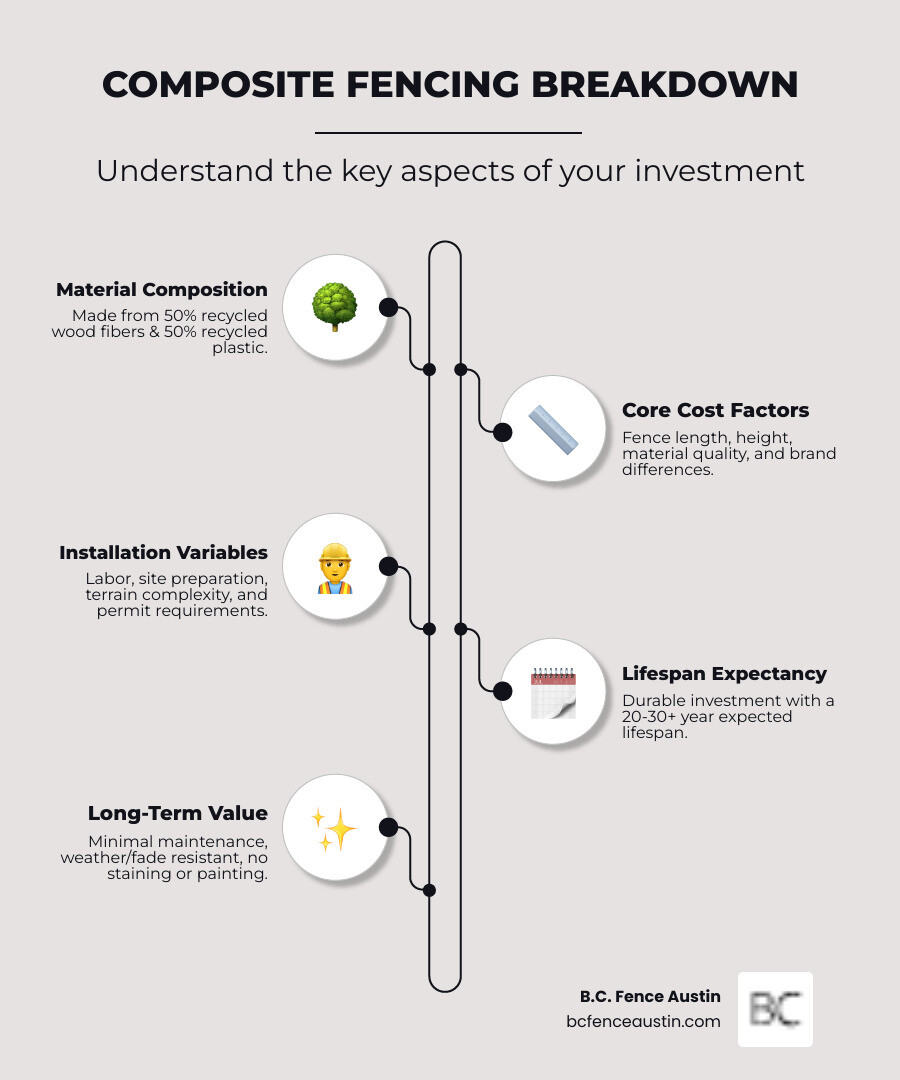
Key Factors That Determine Your Composite Privacy Fence Cost
Your composite privacy fence cost is shaped by your specific property and preferences. There’s no single price that fits everyone.
The most obvious factors are fence length and height. A taller, longer fence requires more material and labor, including deeper post holes for stronger support against wind. Just as important, not all composite materials are the same. Premium brands offer better UV protection, more realistic textures, and superior durability, often backed by longer warranties.
Your property’s terrain also impacts the bottom line. Installing a fence on flat, clear ground is straightforward. However, slopes, rocky soil, or heavy vegetation increase labor costs. In Austin, our limestone-heavy soil often requires specialized equipment to dig post holes, adding time and effort.
Site preparation, such as clearing brush or leveling ground, is another essential step that adds to the budget but ensures a long-lasting fence. Finally, the labor component covers skilled installation. Experienced crews ensure your fence is structurally sound, properly aligned, and built to last, saving you money on future repairs.
Before committing, review our guide on Choosing the Right Fence Material for Your Yard to ensure composite is the right fit.
How Fence Design Influences the Overall Investment
Your chosen style affects the final cost. A basic picket-style fence uses less material than full privacy panels, which require more material for complete coverage. Premium designs can lift your fence with features like lattice tops for visual interest or decorative post caps for a polished look. Mixed-material designs, combining composite with aluminum or stone, create a custom appearance. Each choice adds character but also influences your investment. We help homeowners create a Residential Fence for Outdoors that fits their style and budget.
Understanding the Breakdown of Your Composite Privacy Fence Cost
Here’s where your money goes:
- Material expenses cover panels, posts, rails, and hardware. The brand, quality, and type of composite all influence this cost. Higher-end materials cost more but deliver better long-term performance.
- Labor and installation is often the largest portion of your investment. Professional installation ensures your fence is structurally sound and compliant with local codes. This is not a corner to cut.
- Post-setting is the foundation. Posts must be set at the correct depth and secured with concrete, which can be challenging in Austin’s rocky soil.
- Old fence removal is an additional labor cost if you’re replacing an existing fence.
- Permit requirements from the city or your HOA are another potential cost. We help steer these requirements in Cedar Park, Leander, Round Rock, and our other service areas.
Add-Ons and Customizations to Consider
Add-ons can boost functionality and curb appeal, contributing to the overall composite privacy fence cost while adding value.
- Gates are essential, from simple walk-through gates to wider double gates. Custom designs and automatic openers are also available.
- Post caps provide a finished, polished look. Options range from simple flat caps to ornate designs in various materials.
- Hardware choices like stainless steel hinges and latches prevent rust and ensure smooth operation for years.
- Mixed-material elements, such as aluminum rails or stone pillars, create a distinctive, custom look for your property.
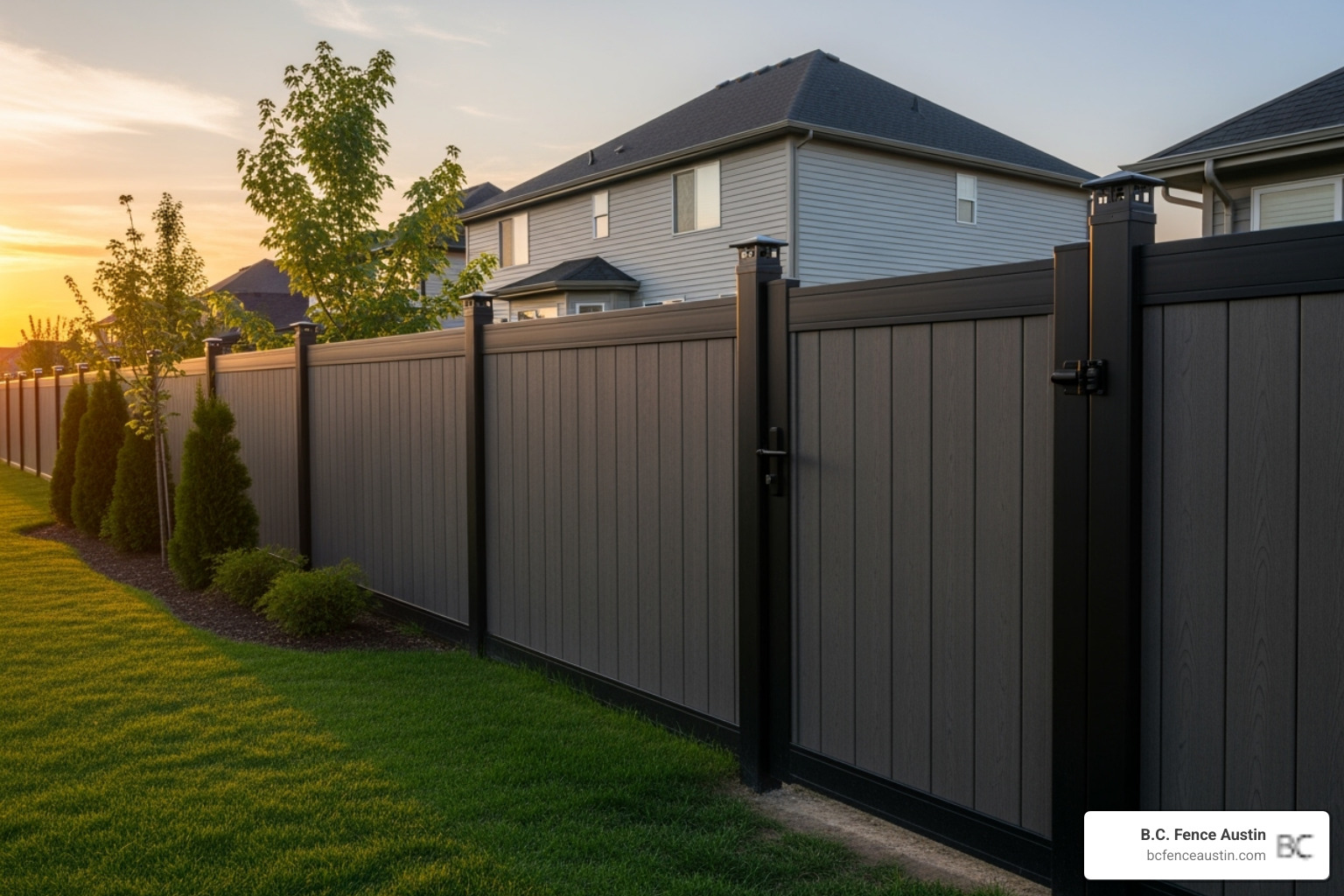
Composite vs. Other Fencing Materials: A Value Comparison
When choosing a fence, look beyond the initial price tag. The cheapest option upfront often becomes more expensive over time. While composite fencing typically requires a larger initial investment, its durability, minimal maintenance, and long lifespan often make it the smarter financial choice. You’re not just buying a fence; you’re buying decades of privacy and peace of mind.
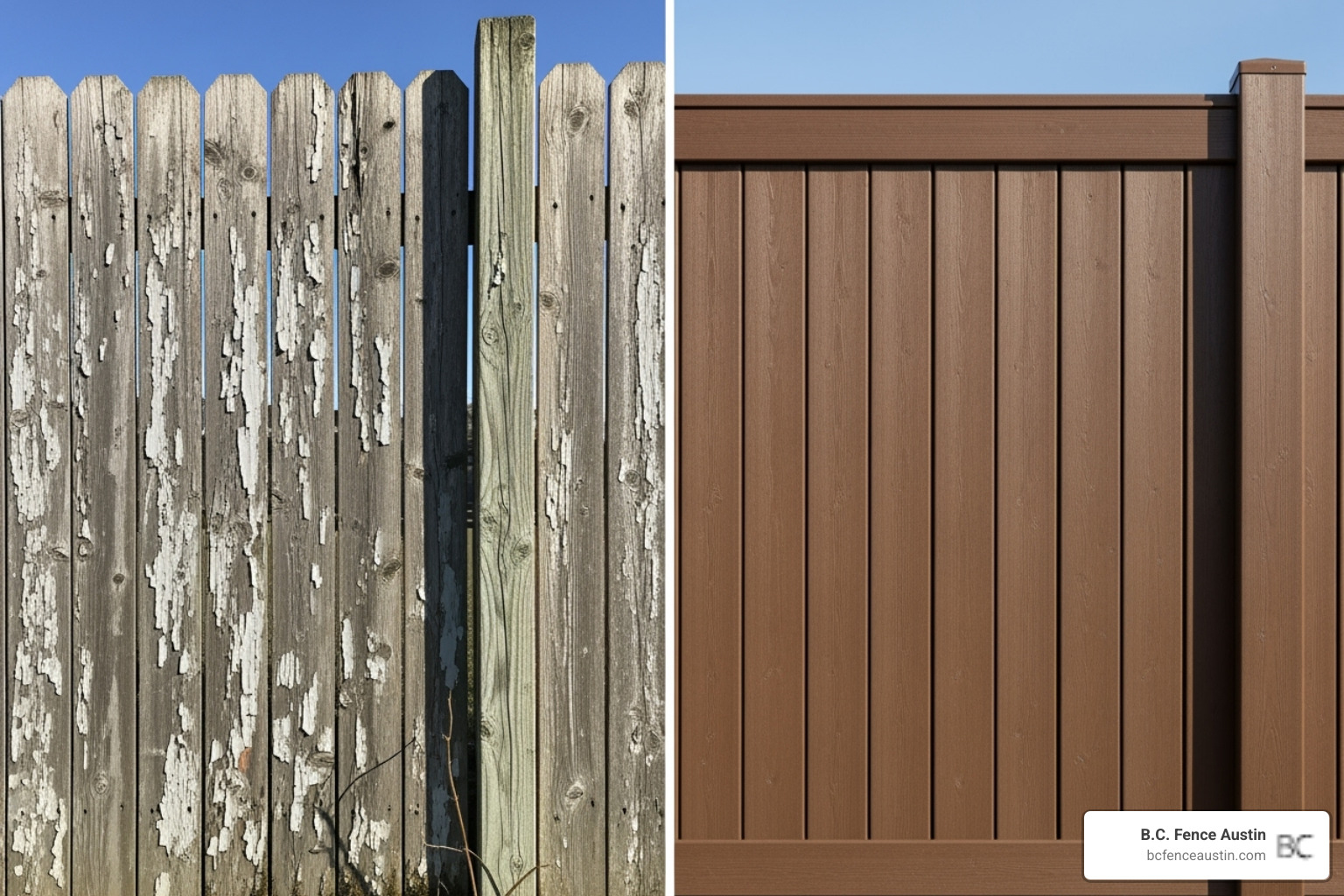
Composite vs. Wood Fencing
A classic wood fence is appealing and often has a lower upfront cost. However, that initial savings is quickly offset by required maintenance. Wood demands regular staining or painting to protect it from Austin’s sun and humidity, preventing warping, cracking, and rot. It’s also vulnerable to termites and other pests. A wood fence might last 10 to 20 years, but only with this constant upkeep.
Composite fencing, engineered from recycled wood fibers and plastic, avoids these issues. It won’t rot, warp, or splinter, and insects ignore it. The higher composite privacy fence cost is essentially a pre-payment for decades of hassle-free ownership. With a lifespan of 20 to 30+ years, the savings on maintenance and your personal time add up significantly. For more on material differences, see our comparison of Vinyl Fences Versus Wood Fences.
Composite vs. Vinyl Fencing
Both composite and vinyl are low-maintenance champions, but the real difference is appearance and feel. Vinyl fencing, made from PVC, has a clean, uniform, and distinctly plastic look. It’s tough, resistant to rot and pests, and easy to clean.
Composite fencing bridges the gap by offering a more natural look. Containing real wood fibers, it has a realistic texture and rich tones that mimic real wood. It provides the authentic aesthetic of wood without the maintenance. Both materials handle Texas weather well, but composite is formulated to resist fading and has a more substantial, sturdy feel. If you want an authentic wood look without the work, composite is your answer. Explore more in our guide on Fence Comparisons: Materials.
Composite vs. Aluminum Fencing
For privacy, composite and aluminum serve very different purposes. Aluminum fencing is sleek, sophisticated, and maintenance-free, but its open picket design doesn’t block the view. It’s perfect for defining boundaries and adding security without sacrificing openness.
Composite privacy fencing, with its solid panels, is built for complete visual privacy. It creates a secluded backyard retreat, perfect for enclosing pools or patios. Aesthetically, aluminum offers a contemporary, architectural feel, while composite brings a natural warmth that blends with landscaping. Both are exceptionally durable, so the choice depends on your primary goal: privacy with a natural look (composite) or an open, decorative boundary (aluminum). Learn more on our Aluminum Privacy Fence page.
The Installation Process: DIY vs. Professional
One of the biggest decisions you’ll make is whether to install your fence yourself or hire professionals. This choice significantly impacts your final composite privacy fence cost and the longevity of the result.
A DIY installation seems like a way to save on labor, but installing a composite fence is more complex than it appears. It requires precise measurements, proper post setting, careful panel alignment, and knowledge of local building codes. The necessary tools, like a power auger for Austin’s limestone soil, and the significant time commitment can stretch over several weekends. Mistakes during installation can lead to structural problems, voided warranties, or repairs that cost more than professional installation.
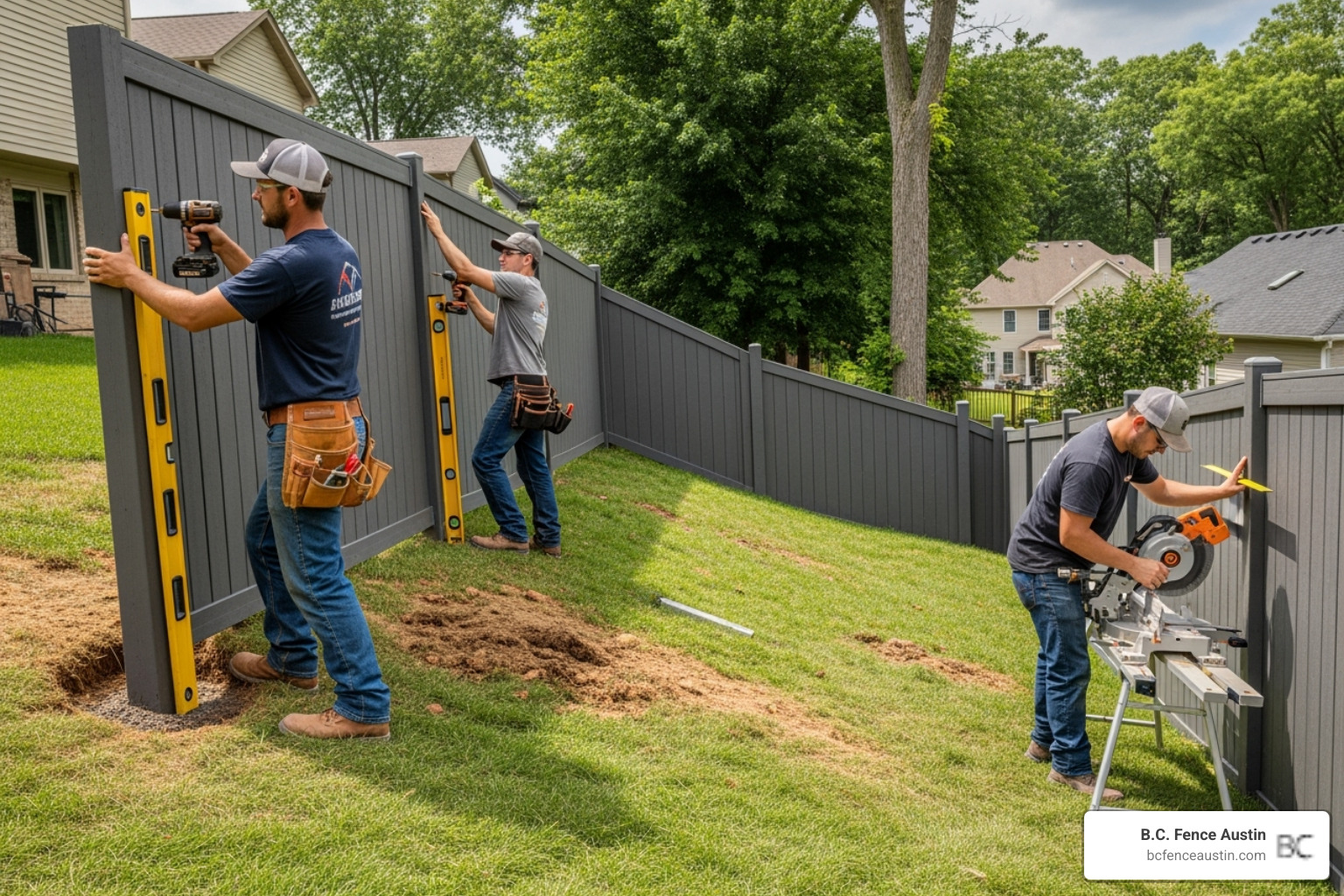
The Case for Professional Installation
Most homeowners choose professional installation for good reason. It’s about more than just convenience.
- Structural Integrity: Professionals understand how to set posts in Austin’s soil and space components for maximum stability, ensuring your fence withstands Texas weather. The Importance of Proper Fence Installation cannot be overstated.
- Local Codes and Regulations: We handle city ordinances and HOA requirements in areas like Cedar Park, Leander, and Round Rock, ensuring your project is compliant.
- Difficult Terrain: Our crews have the right tools and experience to handle slopes, limestone, and uneven ground, guaranteeing a level fence regardless of the challenges.
- Time and Effort: Professional installation saves you from exhausting weekend labor, letting you enjoy your new fence sooner. We handle everything from prep to cleanup.
- Avoiding Costly Mistakes: Professionals know How to Avoid Common Mistakes When Installing a Fence, like hitting utility lines or misaligning posts, which can lead to expensive fixes.
Considerations for a DIY Project
If you’re still set on the DIY route, go in with your eyes open. Composite privacy fences are more complex than they look, requiring precise alignment for a seamless appearance. The materials are also heavy, adding to the physical challenge.
You’ll likely need to rent specialized tools, and it’s crucial to follow manufacturer instructions precisely. These materials expand and contract differently than wood, and improper fastening can void your warranty. Finally, be aware of legal and property considerations. Confirm your property lines and secure any necessary permits to avoid fines or legal disputes. We recommend reviewing Fence Installation: Legal Facts You Need to Know Before You DIY before starting.
For most homeowners, professional installation is the smarter investment, providing quality, warranty protection, and peace of mind that outweighs the potential savings on labor.
Maximizing Your Return: Lifespan and Long-Term Value
The true value of your composite privacy fence cost is revealed over time through minimal maintenance and reliable performance. Unlike a wood fence that demands constant attention, a composite fence takes care of itself after installation. It’s built to resist Austin’s intense summers and freezes without warping, rotting, or losing its appeal.
This weather resistance is part of the material’s DNA. The blend of recycled wood and plastic creates a fence that stands strong against UV rays and humidity. After some initial natural fading, the color stabilizes and remains true for years. It’s a smart choice for the demanding Austin climate. Before starting, review these 10 Things to Consider Before Installing a New Fence to make an informed decision.
Typical Lifespan and Durability
Composite fencing is engineered to last 20 to 30 years or more, often outlasting both wood (10-20 years) and vinyl (20-30 years). This longevity is possible because the material is inherently resistant to rot, termites, and splintering. In Austin’s climate, it maintains its structural integrity without the buckling or warping that affects other materials. This durability means you’re investing in decades of reliable privacy and security.
| Material | Typical Lifespan | Maintenance Level |
|---|---|---|
| Wood | 10-20 years | High (staining, sealing, repairs) |
| Vinyl | 20-30 years | Low (occasional cleaning) |
| Composite | 20-30+ years | Very Low (minimal cleaning) |
Maintenance: Saving Time and Money Over the Years
With a composite fence, you won’t spend weekends staining, sealing, or replacing boards. The maintenance is refreshingly simple: scrub your fence twice a year with hot, soapy water and a soft-bristle brush to prevent mildew and keep it looking fresh. That’s it. No pressure washing, sanding, or painting.
This minimal upkeep leads to substantial savings in both money and time. The long-term cost of ownership for composite is significantly lower than for wood, making it an economically smart choice despite the higher upfront investment. For a deeper dive, there’s further reading on fencing cost factors that details these considerations.
How to Get the Best Value from Your Fencing Project
Maximizing your investment starts with smart planning.
- Schedule Strategically: Consider installation during the fall or winter off-season, when contractor availability may be better.
- Plan Your Layout: Use a tall privacy fence only where you truly need it. A shorter fence in other areas can optimize material usage and reduce your composite privacy fence cost.
- Focus on Functional Features: Prioritize essentials like well-placed gates and finishing touches like post caps. You can trim expenses on ornate elements in low-visibility areas.
- Get Multiple Estimates: This helps you compare options and ensure you’re getting a fair price.
- Handle Prep Work: If you’re handy, clearing the fence line or removing an old fence yourself can sometimes reduce the project scope. However, always rely on professional installation for the fence itself to ensure structural integrity.
For more ideas, see our guide to Budget-Friendly Residential Fencing Options for Homeowners.
Frequently Asked Questions about Composite Fencing
Homeowners often ask the same thoughtful questions when considering their fencing options. Here are the answers to the most common ones.
Is composite fencing a better long-term investment than wood?
Yes. While wood is cheaper upfront, its total cost grows over time due to constant maintenance (staining, sealing, repairs) and a shorter lifespan of 10-20 years. Composite fencing costs more initially but lasts 20-30+ years with minimal upkeep. You pay once for decades of hassle-free ownership, making it a smarter long-term financial choice for busy homeowners.
How much maintenance does a composite fence really need?
Composite fencing is engineered to be low-fuss. The maintenance routine is simple: scrub the fence twice a year with hot, soapy water and a soft-bristle brush to keep it clean. For tougher spots, a composite deck cleaner can be used. There is no need for staining, sealing, painting, or replacing rotted boards. This saves you countless hours and the recurring expense associated with wood fence upkeep.
Does composite fencing hold up well in the Texas heat and sun?
Absolutely. Composite fencing is specifically engineered for harsh conditions like the Texas climate. The blend of plastic and wood fibers resists UV rays, moisture, and extreme temperature swings. Unlike wood, it won’t crack, warp, or rot under the relentless sun and humidity. After a brief initial fading period, the color stabilizes and maintains its integrity for years, making it an exceptionally durable choice for Austin and the surrounding areas.
Conclusion: A Smart, Lasting Investment for Your Property
After exploring the composite privacy fence cost, it’s clear this is a long-term investment in your property. While the upfront cost is a key consideration, the lifetime value is what truly stands out.
You’re getting a fence with remarkable durability, built to stand strong for 20 to 30+ years through Texas weather. The low maintenance reality is a game-changer, freeing your weekends from scraping and staining. A quick cleaning twice a year is all it needs.
This lasting beauty adds genuine curb appeal and property value. It’s an improvement that pays you back in both daily enjoyment and long-term worth.
At B.C. Fence Austin, we’ve helped countless homeowners in Austin, Cedar Park, Leander, and Round Rock transition to composite fencing. We understand the local challenges, from limestone soil to HOA rules, and our expertise ensures your fence delivers on its promise of lasting performance. The right fence transforms your yard into a private retreat, and that’s the real return on investment.
If you’re ready to explore what composite fencing can do for your home, we’d love to talk. Explore your privacy fence options with us today.
A composite privacy fence isn’t an expense—it’s an investment in your home, your time, and your quality of life.
